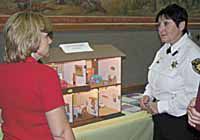| Margene Hansen of Carbon County Dispatch speaks with one of the attendees of the earthquake seminar given by Ed Yeates on Thursday at the Price Civic Auditorium. The presentation was accompanied by a great deal of literature and information for citizens to take home and mull over and, hopefully, act upon. |
Most longtime residents remember a few minor earthquakes occurring in the local area, but it has been generally accepted that Carbon County will not be one of the prime areas in Utah to be affected if a large one were to occur again.
However, people who believe the Castle Valley area will not be affected by a major earthquake along Utah’s Wasatch Front should think again, according to Ed Yeates, KSL television science specialist and authority on quakes in the state.
“There are prime areas in the state where large quakes would be considered most likely, but the entire state is in an earthquake zone and precautions should be taken as such,” Yeates told a gathering of about 400 residents at the Price Civic Auditorium last Thursday. “Everyone knows about the Wasatch Fault. But this area has its own worries, including the Joes Valley Fault, which runs within 20 miles of here, and the Strawberry Fault which is about 40 miles away.”
Yeates was in Price at the invitation of the local emergency preparedness committee. During the presentation, he explained how quakes work and pointed out that, often, the epicenter is where the least damage occurs.
“A good example was the Mexico City quake,” noted Yeates. “The epicenter was out in the ocean, near the coast, and that area had very little damage. But the long waves of the event moved inland and hit Mexico City, which caused large amounts of destruction.”Mexico City is built on an old lake bed that experts indicate “liquefies” when hit with certain kinds of waves. Salt Lake City is built on a similar type of terrain.
“The big one will probably occur along the Wasatch Fault very soon in terms of geologic time,” said Yeates.
In the areas studied along that fault, scientists have determined a major quake happens every 1,200 years, said Yeates. And in the areas, an earthquake is overdue.
“But quakes of 5 to 6.5 on the Richter scale can occur anywhere in Utah. And a quake along in the most populous part of the state could affect Carbon County even if it wasn’t within 50 or 60 miles of you,” said Yeates.
A quake on the Wasatch Fault would affect the Castle Valley area in terms of evacuations, disruption of transportation and supplies and would create an enormous financial burden on the entire state.
Earthquakes cause not only great financial and materials losses, but basically scare the daylights out of people and affect their mental health as well.
According to most experts, preparedness for earthquakes carry over into other disasters as well. Attitudes are important and people can be classified into having one of four kinds.
•Individuals who want to turn the responsibility of their well being over to someone else.
•Individuals who are willing to make the effort to be prepared and who will be able to reach out to assist others.
•Individuals who are truly unable to help themselves.
•Individuals who are clueless and/or misinformed.
“We live in vertical fault country,” Yeates told the audience. “That means when these faults move they cause a lot of destruction. Many faults are unknown as well. In 1988 there were two earthquakes here in the area. One of the epicenters was in the San Rafael Swell the other in the Wasatch Plateau. No one even knew there were faults in those areas.”
Yeates showed pieces of videos he helped produce on earthquake safety, including one produced in 1989 that actually used a house on the east side of Salt Lake and showed what would happen to the people inside should a quake happen in the middle of the night.
“Probably the two most important things you can do is to have a flashlight in a drawer right at your beside at all times,” he said. “The other is to always have a pair of shoes next to your bed. When an earthquake occurs everything on the walls or in cupboards is usually on the floor and much of it is in pieces.”
Yeates pointed out that unlike the recent hurricanes that have struck Florida and the Gulf Coast there is absolutely no warning, and the aftermath is sometimes worse than in tropical storms. Damage includes falling debris and broken glass, homes that while standing become uninhabitable, power, water, gas and phone disruptions, chemical hazards, flooding caused by broken dams of displaced lakes, cross contamination between water lines and sewer lines, fires with no water to fight them, and all professional response services overwhelmed.
Yeates said people often react inappropriately to a shaking building. They often run out of the building while the quake is still going on and that is where many of the injuries occur.
“Sure you should get out of the building when the shaking stops,” he told the group. “But until then you should find cover under anything you can, a desk, a chair or a doorway frame. Then get out. And incidentally, never use an elevator during an earthquake.”
The key factor in earthquake preparedness according to everyone at the presentation was to not think it couldn’t happen here.
“It will happen at some point,” said Yeates. “We just don’t know exactly when.”

